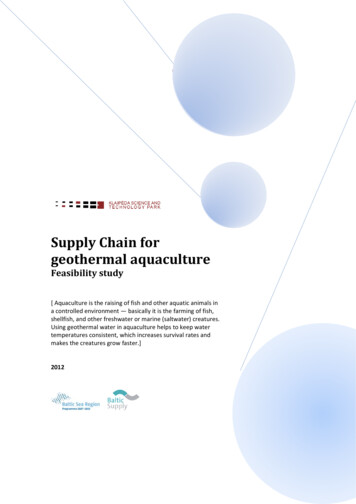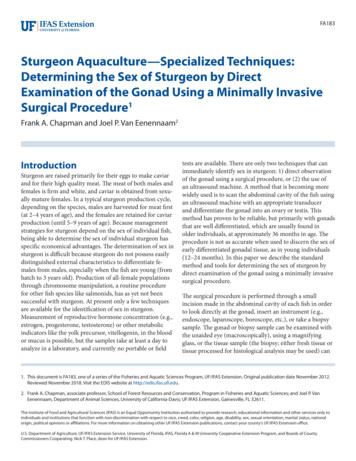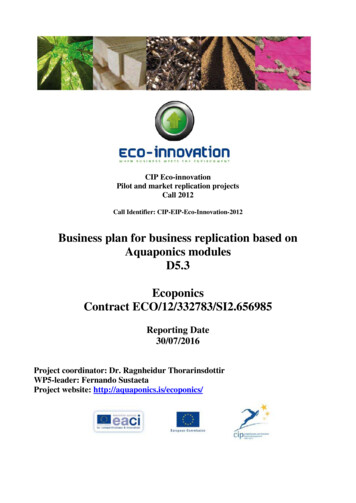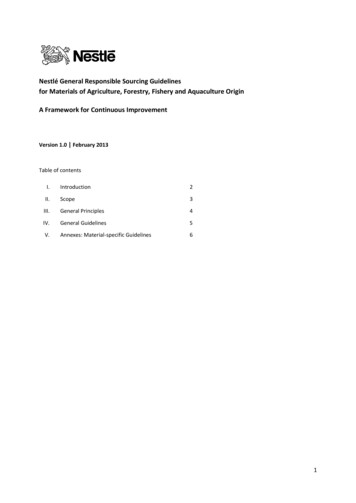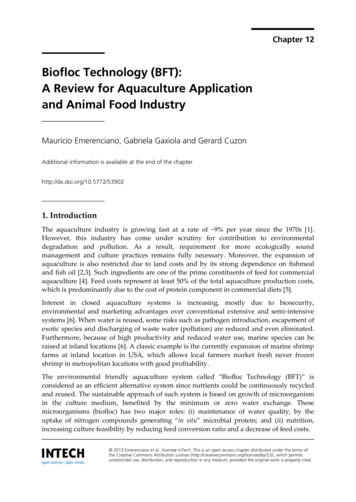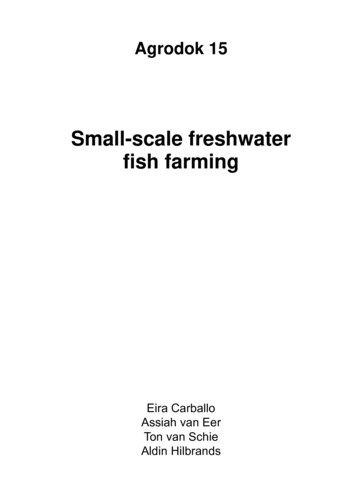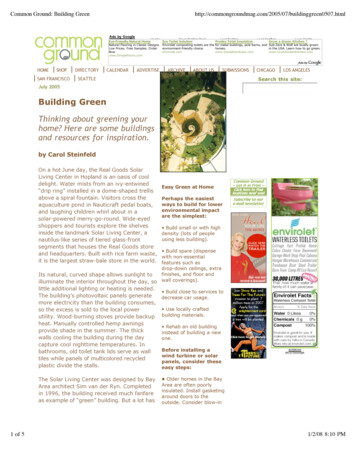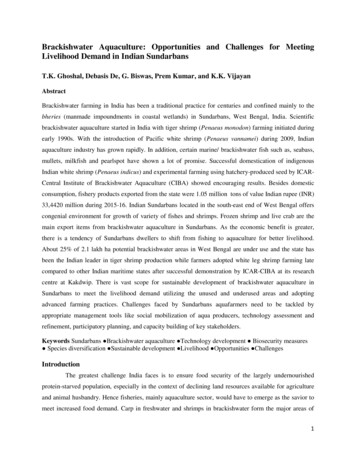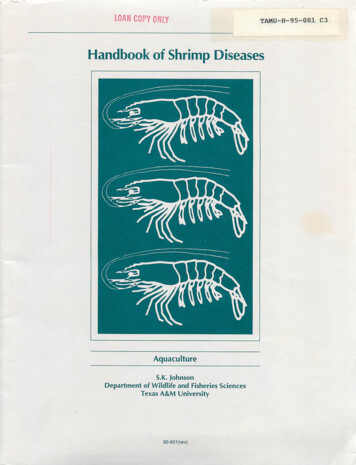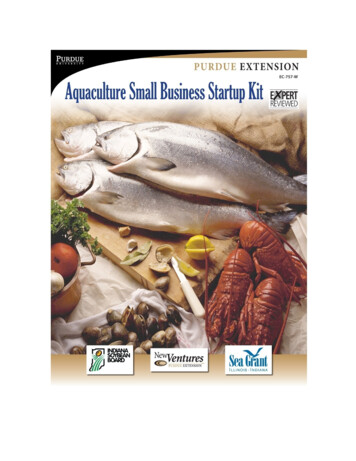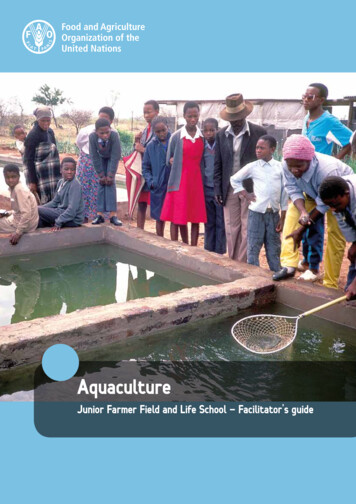
Transcription
AquacultureJunior Farmer Field and Life School - Facilitator’s guide
Cover photo: U. Nermark / FAO
Module: AquacultureJunior Farmer Field and Life School – Facilitator’s guideFOOD AND AGRICULTURE ORGANIZATION OF THE UNITED NATIONSRome, 2015
ii The designations employed and the presentation of material in this information product do not implythe expression of any opinion whatsoever on the part of the Food and Agriculture Organization ofthe United Nations (FAO) concerning the legal or development status of any country, territory, city orarea or of its authorities, or concerning the delimitation of its frontiers or boundaries. The mention ofspecific companies or products of manufacturers, whether or not these have been patented, does notimply that these have been endorsed or recommended by FAO in preference to others of a similarnature that are not mentioned.The views expressed in this information product are those of the author(s) and do not necessarilyreflect the views or policies of FAO.ISBN 978-92-5-108143-3 (print)E-ISBN 978-92-5-108144-0 (PDF) FAO, 2015FAO encourages the use, reproduction and dissemination of material in this informationproduct.Except where otherwise indicated, material may be copied, downloaded andprinted for private study,research and teaching purposes, or for use in non-commercialproducts or services, provided thatappropriate acknowledgement of FAO as the sourceand copyright holder is given and that FAO’sendorsement of users’ views, products orservices is not implied in any way.All requests for translation and adaptation rights, and for resale and other commercialuse rightsshould be made via www.fao.org/contact-us/licence-request or addressed tocopyright@fao.org.FAO information products are available on the FAO website (www.fao.org/publications)and can bepurchased through publications-sales@fao.org.
AquacultureTable of ContentsAcknowledgements1Introduction1Opening energizers3Factors for success6Exercise 1: Make your own mini pond in a bottle7Facilitators’ Notes8Exercise 2: Resource Inventory9Exercise 3: Planning our fish production10Facilitators’ Notes10Factors for commercial success13Exercise 1: What should I produce and who will buy it?14Facilitators’ Notes15Exercise 2: Who wants to Buy My Fish?15Facilitators’ Notes16What are the risks?17Exercise 1: Identify Risks18Exercise 2: How to mitigate risks18Facilitators’ Notes20Organizational structures21Exercise 1: Organizations22Facilitators’ Notes23Food safety and hygiene24Exercise 1: Learning hygiene practices25Facilitators’ Notes25Exercise 2: How germs spread26Facilitators’ Notes27How to grow fish28Exercise 1: Building and using a bamboo frame cage29Facilitators’ notes30Exercise 2: Feeding our fish31Facilitators’ notes32Exercise 3: How to Grow Fish in a Pond – Getting Started33Facilitators’ Notes34Potentitial impacts on environment35Exercise 1: What’s wrong with this picture?36Facilitators’ Notes39References40iii
iv AcknowledgEmentsThis Facilitator’s Guide on Aquaculture complements a number of existing Junior Farmer Field andLife School (JFFLS) Facilitator’s Guides on other subjects (available at: www.fao-ilo.org/?id 20904). Itis a joint production of FAO’s Fisheries and Aquaculture Department, Economic and Social Departmentand the Natural Resources Management and Environment Department with financial support ofSweden through the FMM FAO Multidonor Mechanism. It has been prepared by Dr. Kathleen Castro,Laura Skrobe, Barbara Somers and Christopher Parkins of Fisheries Specialists under the supervisionof Nicole Franz and Daniela Kalikoski as part of youth development initiatives within the Fisheries andAquaculture Department. FAO staff from the above-mentioned departments offered valuable inputand feedback on the draft. Special thanks are due to Francesca Dalla Valle, Matthias Halwart, KatrienHolvoet, Reuben Sessa, Susanna Siar, Rohana Subasinghe and Tamara van’t Wout.The constant support received from Jan Peter Johnson, Olga Navarro and Emily Rodriguez indeveloping this publication is particularly appreciated.Fabrizio Puzzilli provided the layout for the Facilitator’s Guide on Aquaculture in collaboration withIlaria Perlini, Emily Donegan provided the illustrations.
Module: Aquaculture
AquacultureINTRODUCTIONSustainable capture fisheries and aquaculture play a critical role in food and nutrition securityand in providing for the livelihoods of millions of people. Aquaculture accounts for a growing shareof the global aquatic food production. The term aquaculture covers all forms of farming of aquaticanimals and plants in freshwater, brackish water and saltwater. Aquaculture has the same objectiveas agriculture – the controlled production of food to improve the supply for our consumption. In thecase of aquaculture, the products are aquatic animals and plants that grow in the water.Even in small quantities, fish can have a positive effect on the overall health and nutrition ofhumans. Fish is an important source of nutrients such as vitamins A, B and D, calcium, iron andiodine. Fish also provides vital amino acids that are often lacking in staple foods such as rice orcassava. It is therefore vital to the food security of many of the world’s poor, especially in coastal areasand in small island developing States. Through aquaculture, we can produce protein and nutrient-richfood throughout the year.Low-income farmers who invest in fish farming will be able to generate additional income and foodfor their family and potentially for the market. To be successful, an aquaculture operation requiresmuch careful planning. The available natural resources, such as water and land, but also the localtemperature and other factors influence the choice of the species to be farmed and the productionsystem to be used. Climate does not limit the scale of aquaculture but it can determine the speciesthat can be grown. Aquaculture can be done in a pond, a river, a lake, an estuary or in the sea. Theavailability of high-quality water is usually the most crucial resource when making decisions aboutwhere, what and how much fish to farm. The most common small-scale aquaculture systems aresmall-pond fish farming and fish farming in lakes, rivers, dams and reservoirs.Climate change may have various negative impacts on aquaculture, including sea-level andtemperature rise, rainfall fluctuations, and natural hazards such as floods and drought (FAO, 2009).Sea level rise, for example, may threaten inland freshwater aquaculture by causing saltwater andbrackish water to move further upstream and into rivers. Existing waterbodies may also shrink ortheir water levels may decrease owing to erosion, drought and increasing temperatures. Increasingtemperatures may also lead to lower levels of dissolved oxygen in the water, which would increasemortality of fish.Through various exercises, such as small group discussions, hands-on tasks and demonstrations,Junior Farmer Field and Life School (JFFLS) participants will learn about the various types ofaquaculture that can be used to provide new business opportunities for farmers and fishers. Theywill also learn about the importance of preliminary planning and management of daily activities andprocedures to ensure a successful aquaculture business.At the end of the module participants will: be aware of the various types of aquaculture; value aquaculture as a means of livelihood diversification and as a business opportunity; understand the importance of careful planning.The purpose of the module is to provide guidance, making available different exercises thatfacilitators can use as applicable, and adapt as necessary, to the specific socio-economic andcultural contexts and needs of each target group and country in which the module will be used. ThisJFFLS module is complementary to other JFFLS modules, in particular Capture fisheries and Postharvest issues in fisheries and aquaculture, and can be combined with them to enhance economicopportunities.1
AquacultureÔÔOpening EnergizerOBJECTIVE:Break the ice by getting to know one another and by introducing the topic of aquaculture.TIME:30 minutes (15 minutes per exercise).MATERIALs:Stopwatch or clock; whistle or other noisemaker.Steps (exercise 1):1. Explain participants that one after the other they should say their name and a food itemthat begins with the same letter as their name, such as “My name is Elsa and I like to eateggplant” (alternatively a place or a city can be said, for example, “My name is Brittany, I amfrom Bangladesh”).2. To make the game more challenging, ask participants to remember all the names and foods/places of all those who speak before them: “The last person will have to try to repeat all theparticipants’ names and foods/places.” For young children, it is easier to ask them to onlyrepeat the name of the child who precedes them.Steps (exercise 2):1. Ask students to form pairs of two (ideally a male and female participant), to introducethemselves to their partner and to chat for about 5 minutes about what they know aboutaquaculture, for example by answering the following questions: What do you think aquaculture means? Do you know somebody who farms fish? How long does it take to grow a fish? Does your family or neighbour or a relative grow fish?2. When 5 minutes are up, blow the whistle and gather as one big group.3. Ask each of the participants to introduce his/her partner to the whole group and to brieflyreport on what the partner knows about aquaculture.3
Exercises
6 ÔÔFactors for successGlobally, an enormous variety of waterbodies, including rivers, irrigation canals,flood plains, lakes and ponds, can be used for fish farming. To be successful, itis very important to focus aquaculture production on species that are easy tomaintain and that can live with available resources (e.g. natural habitat, feed,including household waste). Some fish and shellfish are relatively easy to breedand grow and require no or little technology or intervention. Normally, it is easierto farm fish that eat plants rather than fish that eat smaller fish species and canhave complex life cycles that are difficult to recreate in our aquaculture systems.A little homework ahead of time to understand which species can be farmed withlocally available resources will save money, time and frustration.
AquacultureTT exercise 1make your own mini pond in a bottleOBJECTIVE:Recreate and observe the fish life cycle to understand the complexities of growing fish on a smallscale and the importance of having a balanced ecosystem.TIME:About 2 hours and additional observations for 4 weeks.MATERIALS: 2 two-litre transparent bottles, clean and without label (one bottle for each group of 5–6 people). Thermometer. Pipette or straw or piece of tubing. Tape. Pond water. Sand. Two species of juvenile fish from a local pond (for example, cichlids and catfish; three foreach bottle). Pond cultures of algae (if available). Water plants (for example, African elodea or water hyacinth). Aquatic snails and other invertebrates (for example, pond snails , apple snails or pulmonatesnails). Scissors. Writing support. Pens.STEPS:1. Divide the group into small gender-balancedgroups of 5-6 people, depending on class size.2. Have each group cut the top curved portion ofthe bottle off and keep it.3. Ask participants to put about 7.5 cm of sandinto the bottom of the bottle and carefully addthe pond water until the bottle is about half-full.4. Invite participants to plant the water plants. A good rule of thumb is to plant two plants foreach fish.5. Participants should slowly add more pond water, being careful not to disturb the sand orplants, and fill the bottle to within 2.5 cm of the top.6. Ask participants to add the snails and any other invertebrates (maximum of 5 invertebratesper bottle).7. Place the bottles in a safe and dry place and leave them undisturbed overnight.8.The following day, participants should add two or three small fish to each bottle. After the fishare in the water, the top with the bottle cap can be put back on the bottle and sealed with tape.7
8 9. The bottle ecosystem should be placed near a light source, but be careful that thetemperature does not go above 25oC. Algae growth should be encouraged. Feed the fish onlyif you feel they cannot survive.10. Once a week each group should add a few drops of water with the pipette, straw or piece oftubing.11. Invite each group to observe the ecosystem in their bottles over the following weeks and toregister their observations (e.g. temperature, water level, condensation, general health ofanimals). It would be best if a different group member could take the bottle home for a weekand make daily observations. The bottle can then be passed to another group member thefollowing week, etc.12. After a few weeks, discuss the following: Is one ecosystem developing better than the others? Is one species in the bottles more aggressive? If too many fish are in the bottle, what happens? If the fish are dying, what should be done to correct it? If too many decomposers are in the system, the water may become cloudy. What should be done?13. Close the discussion with the entire group by talking about the importance of a balancedecosystem for aquaculture.55 facilitators’ notesAll ecosystems, whether on land or water-based, require three basic components: producers,consumers and decomposers. Producers, consumers, and decomposers must all remain in balance forthe ecosystem to thrive. Too much of one of these will result in disaster. For example, if there are toomany fish and not enough plants, the fish will starve or will suffocate from lack of oxygen. Therefore, itis important not to overcrowd the environment.The producers are the plants, so named because they produce their own food and are the base of thefood web. They also produce oxygen, essential for the consumers. After a few days of observing, it maybe necessary to add more plants to provide food and oxygen if some of the fish begin to die.Consumers are the animals and living organisms thatfeed off the producers, so named because they consumethings in the environment. Consumers also contributecarbon dioxide and waste to the ecosystem.Decomposers are the garbage cleaners of the ecosystembecause they recycle the waste products. Decomposersinclude bacteria and worms. In a water system, snails andghost shrimp are decomposers.
AquacultureTT exercise 2Resource InventoryOBJECTIVE:Have participants think and discuss about their locally available resources.TIME:About 1 hour.MATERIALS:Flip charts, markers.STEPS:1. Ask participants to identify some of the natural resources they come across in theenvironment during their day-to-day activities and record all the responses on a flip chart.2. Divide the participants into gender-balanced subgroups of 5–6 persons.3. Ask each of the groups to make a map of water sources in the area. The map should haveenough detail to show rivers and streams that may flow into it, trees, fields etc. Each groupshould also map other local resources that support fish farming (e.g. feed sources, fishmarkets, fish processing sites, transport facilities, financial services, extension services).4. When the groups have finished, they should nominate one group member to present theirmap.5. Participants should compare the different communities presented and discuss whatthe differences are and which resources for aquaculture are missing in the differentcommunities.6. Discuss with participants: Is there any problem with these resources? Are there any differences in quality among these resources? What happens when the community does not take good care of these resources?7. To conclude, summarize the discussion highlighting the constraints and advantages foraquaculture production in the area.9
10 TT exercise 3planning our fish productionOBJECTIVE:Identify the type of aquaculture that will work best for the community and understand whichfactors are important for fish farming.TIME:2 hours.MATERIALS:Flip charts, markers.STEPS:1. Take the group to the nearest body of water.2. Divide the participants into gender-balanced sub-groups of 5-6 persons.3. Ask them to develop a step-by-step plan of what they have to do in order to farm fish,thinking about species selection, site selection, system preparation, feed selection,fertilization, harvesting methods, post-harvest storage etc.4. Bring the participants back together and have them present their plans to the full group.5. Conclude the session by asking the following questions: Is it a good idea to make a plan? Why or why not? What basic steps do we need to follow to make a plan? Was it easy or difficult to make a plan in a group? Did everyone participate in the discussion? Why or why not?6. If available a local aquaculture producer can also be brought in to allow for a similar exerciserelated to the production of products.55 facilitators’ notesThe two most common small-scale aquaculture systems are local pond fish farming and fishfarming in open waters such as lakes, rivers, dams and reservoirs. Small-scale fish farming is mainlya secondary occupation for farmers, and ponds tend to be small (less than 1 000 m2) and withoutwater drainage facilities.Pond cultureSite selection: Site location depend on a number of factors including: the fish species to befarmed; soil quality, which affects water quality and productivity; an adequate supply of unpollutedwater; land ownership; access to markets; fish feed and other inputs available to the farmer; andthe capacity to retain water for more than 1 m for at least 6 months of the year. If possible, the pondshould be located to take advantage of the effect of the wind on the surface of the pond to mix thewater; although locations that are too windy can cause erosion. If the site is very windy, the long sideof the pond should be at right angles to the prevailing wind. Hedges and trees can be used to protectthe pond.
AquaculturePond size: Ideally, the fishpondshould be 0.5–1 m at the shallow end andsloping to 1.5–2 m at the drain end. Drainvalves or tilt-over standpipes should beincorporated into the design. It should bepossible to drain the pond within threedays. The edges of the pond should havea slope of 2:1 or 3:1 on all sides.Pond facility management: There are many potential problems to be considered, including, forexample, broken pond banks. To prevent this, pond walls should be checked on a regular basis.Grazing animals can damage the pond banks and should be kept away. An irregular water supply canalso be an issue, providing too much water in the wet season and too little in the dry season. Predatorsare another threat to production, and the pond needs to be checked regularly for signs of snake andrat holes. In the pond, silting or a buildup of organic matter can be prevented by regular checks of thebottom of the pond and scooping out of silt when required. Mud on the bottom of the ponds can beagitated with a rope to release harmful gases. To avoid leakage, the pond inlet and outlet need to bechecked on a regular basis. The fish itself has to be checked for diseases on a regular basis.Open water fish farmingCages or pens are used to separate an area of larger waterbodies for fish farming. The selectedwater source should be of good quality with low turbidity. Dams and reservoirs primarily exist to storewater but as a secondary function these bodies of water can be stocked with fingerlings or fry andthe fish can be harvested later by using nets. In river locations, a slow current is necessary and thereshould be little disturbance from water traffic.There are several disadvantages to open-water fish farming that should be considered. Theseinclude that fish farmers have little control of the water, as they do not own the dam or reservoir.The risk from theft and vandalism is a serious problem in some places. It is more complicated to feedthe fish or fertilize the water, creating a higher reliance on naturally occurring fish food. In largerwaterbodies, there are likely to be more predators. A significant expansion of cage culture activities insome villages could have negative environmental impacts, leading, for example, to the local depletionof snails on which other animals depend (e.g. birds).Fish cages: A cage is a simple means of restraining fish in one place, and it can be easily madeusing local materials. Cages are used within flowing or large bodies of water and can also be used insmall pond fish culture to protect fingerlings in the initial stages of development. Small cages with acapacity of 1 m3 are suitable for fingerling protection. Cage design must incorporate certain physicalproperties, including the ability to hold fish securely but also to be within the financial means of thecage operators. The cages currently used are small, measuring between 1 and 2 m3, inexpensive andsimple to construct. Bamboo poles can be used to form an outer frame that is covered in netting;inside is a “nursery” section for the younger, more delicate fish; and floats are added at the corners.Farmers use both fixed and floating cages. In general, fixed cages are installed in waters where thedepth is relatively low and poles can be fixed into the river bed or substrate. Floating cages do nothave this limitation and can be used in deep water. Floating cages tend to be easier to manage, butwhen selecting the type and design, the following points should be considered: input availability, riskof natural disasters, type of waterbody, water depth and current, and water retention period over oneyear.Cage managementFixed cages: Fixed cages are very easy to construct and only require a small amount of capitalinvestment. The materials needed to make fixed cages are netting with an 8 mm mesh size, bamboo,rope, twine and sinker. Routine management is difficult for these cages, and storms, strong currents,11
12 tidal surges and flooding may cause damage if precautionarymeasures are not taken. Fixed cages are difficult to movefrom one place to another during water fluctuation. A topcover is usually provided on cages to reduce the risk of fishescaping, especially in areas prone to flash floods wherewater levels rise very quickly. A small opening is kept atone edge or in the middle of the top covering for feedingpurposes. A feeding platform made of fine mesh is placedon the bottom of each cage to minimize food loss. To fixthe cage, four bamboo poles are fixed in the substrate andthe four top and bottom corners of the cage are tied to thebamboo poles with nylon rope, allowing the cage nettingto stretch. To minimize installation cost and to reduce daily management and labour, cages aresometimes fixed in rows with a narrow space between the adjacent cages.Floating cages: The size of the cage is usually 1 m3. Atop net is always used to minimize escapees because thecage is only a few centimetres above the water surface. Thetop of the cage is on hinges that can be opened to allowfeeding, the checking of fish, the removal of waste andharvesting.A layer of fine mesh net is placed along the bottom of thecage and 10 cm up each side to reduce food loss. However,where the water has a high turbidity, the use of fine meshis not recommended as it clogs up the mesh and causesstructural stress on the cage frame. In these areas, feedingtrays should be used instead of fine mesh. Buoyancy isachieved by using four plastic floats (buoys) tied to the fourhorizontal frames, about 10 cm from the top of the cage. There are several advantages to using fixedcages. The cost per unit is very small and they are not damaged by storms. They are easy to constructand the water volume remains constant even with a fluctuation in the water level. Lastly, in tidalwaterbodies, the effective cage depth is greater.Cage maintenance: Maintenance includes: the cleaning of aquatic weeds nearby; removal ofwater hyacinth; cleaning of waste feed from cages; cleaning of deposited silts from cages; removal ofdead fish; checking cage frames, floats, ties, anchors, feeding trays, etc.; cage shifting; consideringthe water level; checking water pollution; and guarding. The care of the net includes the removalof algae to ensure water exchange and the prevention and repair of holes. Profitability depends onproper attention to fish growth, and regular, adequate and quality feed is important. Feed can be oflocal origin, including aquatic weed or a mixture of rice bran, oil cakes, kitchen waste, chopped snailsor cow dung. Fish health should be monitored regularly.Fish types: The selection of suitable fish species for farming will depend on various biologicaland economic factors, such as market price, growth rate, ability to reproduce and available fish feed.Water temperature is also an important criterion in assessing which fish species is suitable. Commontypes of farmed fish are tilapia, Nile perch and catfish.Feeding the fish: It is possible to feed fish on kitchen and agricultural waste, duck weed, oil cake,rice bran and snails, which will provide all the nutrition required. If available and not too costly, thediet may be supplemented with commercially available compound feeds.
Aquaculture13ÔÔFACTORS FORCOMMERCIAL SUCCESSYou should consider a variety of factors when venturing into aquaculture forcommercial purposes. It is important to plan wisely and to do your homework. Inaddition to the available natural resources, evaluate other resources you have,including time, access to energy and financial resources. It is also crucial to assessthe market of the region or community in which you want to sell your fish. Is therea demand for what you are going to produce? Can you make a profit? How are yougoing to sell your product?
14 TT exercise 1What Should I Produce and Who Will Buy It?OBJECTIVES:Identify local markets and their needs.TIME:3 hours.MATERIALS:Paper, pens, writing support, markers.PREPARATION:Before doing this exercise, meet with local fish traders to arrange for a group visit when they arenot too busy. If there are many traders, contact several of them to distribute the group. It will alsobe beneficial to arrange a visit when customers will be purchasing product to capture their viewsas well. Based on the finding of the pre-exercise visit, decide the most appropriate size of thesubgroups.STEPS:1. Introduce the task to the whole group. Working in subgroups, they will decide on twoquestions each for the consumer and the trader to better understand the market needs.Explain that the subgroups will have 15 minutes to complete this task.2. Form smaller gender-balanced groups (adjust the size of the groups to the number of fishtraders and customers, so as not to overwhelm the individuals) and provide them with paperand pen. These groups will work together throughout the exercise.3. After 15 minutes, have a representative from each group present their questions to the class.Write the questions on the flipchart. Once completed, ask the participants if there are anymore questions they would like to add. Use the questions in the Facilitator Notes to stimulateideas within the groups.4. Participants should use all the questions as a guide to engage in conversation with both theconsumers and traders. Explain that a list of questions could make people uncomfortable andthat it is better to have a casual conversation in which the questions are inserted. Participantsshould record the major points, but avoid writing the answers word for word as this canmake the person being interviewed feel as if they are not being listened to. Participantsshould always be polite and thank everyone for their time.5. Bring the participants to the prearranged location and give them an hour to meet with thetraders and consumers. Agree on a meeting point.6. When back, discuss what the participants learned. Based on their feedback, which productwould they want to farm and why? Emphasize the importance of a market survey and explainhow it is done and how it relates to the exercise the groups just participated in.
Aquaculture55 facilitators’ notesParticipants should have an understanding of how to perform a market survey that allowsunderstanding the conditions and the needs of a market. They can use this technique in their localcommunities but they can also use the survey questions as guides when speaking with other importantplayers, such as exporters. Identifying a market is only part of the process; it is also important to makesure that any product chosen to be produced will be sustainable and profitable (for more, see modulePost-harvest issues in fisheries and aquaculture). Participants will want to choose a product that isunique or in demand, rather than to produce one that is already being produced and meeting currentdemand. Shifts in the availability of certain fish species owing to climate change can open the doorto new and profitable aquaculture endeavours.Sample questions for market surveyFor traders What are the most popular products? Are any of the popular products produced through aquaculture? What are the most expensive products? Do they sell well? Does the trader have a problem with obtaining a steady supply of certain products? Are there times of the year when certain products are more popular (e.g. festive seasons)? Is there a preference from the customer as to whether certain products are from aquacultureor wild caught? Are there any export markets for products from aquaculture? What products are imported for sale?For consumers What is their preferred product to purchase? Do they know the difference between fish from capture fisheries and aquaculture fish? What is the biggest factor when deciding what to buy (price, taste, aquaculture vs. wild,etc.)? Are there any other fishery products they would like to see available? Are they able to find their favourite products at all times? Can they
Break the ice by getting to know one another and by introducing the topic of aquaculture. TIme: 30 minutes (15 minutes per exercise). maTeRIals: Stopwatch or clock; whistle or other noisemaker. sTePs (exeRCIse 1): 1. Explain participants that one a
